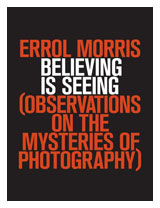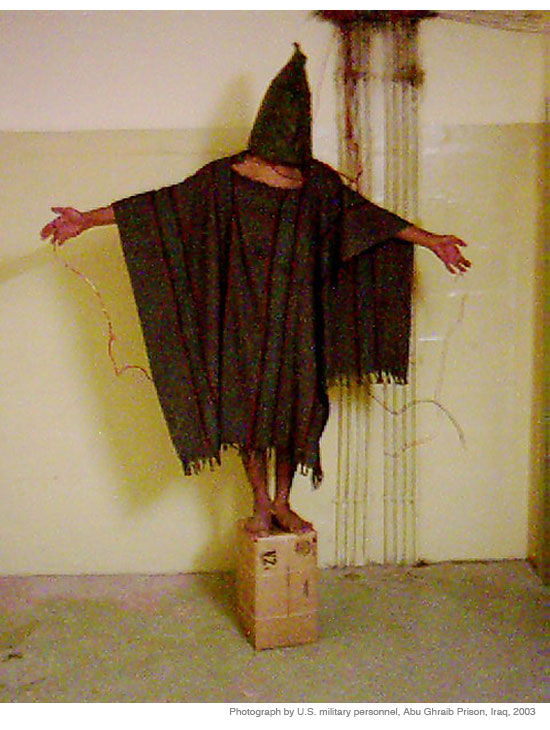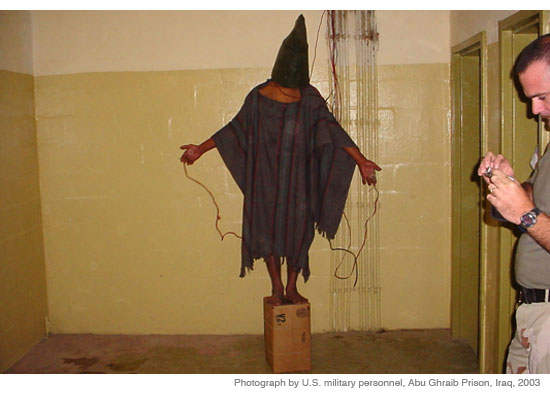Believing is Seeing: Observations on the Mysteries of Photography | by Errol Morris | The Penguin Press | 336 pages, $40.00
Here’s a theory: every year photographs become more ubiquitous, and as that growing ubiquity builds to a certain critical mass, our collective understanding of photography’s place in our lives becomes more and more diluted, and our need to reconsider our relationship to the medium becomes more and more urgent. It’s arguable that the release of the Abu Ghraib photographs was that moment of critical mass for the digital era. Certainly there was no comparable phenomenon in previous photographic history. The photos were taken not by journalists but by soldiers with consumer-quality digital cameras–participants in the story they were documenting–and were rapidly reproduced and disseminated on a global scale. And, proving the fraught nature of our relationship with photography, the images have now spent more than seven years in the public eye, and have managed to become iconic but not understood, as the circumstances they depict remain shrouded in obfuscation, politicization, and mystery.
 The argument that the Abu Ghraib photos themselves (rather than just the horrors they depicted) represented a watershed moment in the relationship between photography and the public was made first and most compellingly by documentary filmmaker Errol Morris in his 2008 film Standard Operating Procedure. And Morris’s new book of essays, Believing is Seeing: Observations on the Mysteries of Photography just might be that much-needed book that codifies our relationship to photography in the post-digital world.
The argument that the Abu Ghraib photos themselves (rather than just the horrors they depicted) represented a watershed moment in the relationship between photography and the public was made first and most compellingly by documentary filmmaker Errol Morris in his 2008 film Standard Operating Procedure. And Morris’s new book of essays, Believing is Seeing: Observations on the Mysteries of Photography just might be that much-needed book that codifies our relationship to photography in the post-digital world.
Though Believing is Seeing ranges widely, dealing with everything from Roger Fenton’s photographs of the Crimean War in 1855 to “photography and memory” during the American Civil War, the essays that deal with contemporary and specifically digital photography are the collection’s lynchpin: the key to the book’s cohesion as well as its relevance. In fact, every essay in the book is itself a product of new media, as each originally appeared in some form on Morris’s blog at nytimes.com. Regardless of whether you’ve read the blog, which features long-form, heavily footnoted essays that are refreshing in their complete disregard for the blog format, it should be noted that Believing is Seeing is not a mere exercise in recycling. The essays have been adapted and arranged into a coherent whole, and people who have read the pieces before will enjoy revisiting them in book form, where they achieve a thematic resonance that failed to come through when published independently.
For me, the highlight of the collection is the pair of essays on Abu Ghraib, particularly the essay on the iconic Hooded Man photograph. Morris’s book is simultaneously an homage to and a warning against the power of images over the human brain (really, all of his work is a mix of fascination and skepticism) and, like many of the photographs Morris deals with in the collection, the Hooded Man has a hugely powerful symbolic meaning that serves to overpower and subvert the factual information the photograph contains.

Morris opens his essay with an explanation of how the image managed to dupe The New York Times, which published a front page story on March 11, 2006 claiming that a former Abu Ghraib prisoner named Ali Shalal Qaissi was the man in the photograph. The story was quickly discredited (Morris makes a strong argument that the Hooded Man was in fact another prisoner named Abdou Hussain Saad Faleh) but the Times was hardly alone in rushing to draw conclusions from the photograph that were not supported by the facts.
Morris explains that there are actually multiple versions of the Hooded Man photograph. The first version, which is the photo (posted above) that everyone thinks of when they think of Abu Ghraib’s Hooded Man, was taken by Staff Sergeant Ivan Frederick, one of the Military Police assigned to Abu Ghraib who was later sentenced to eight years in prison for abusing prisoners. Another photograph was taken just minutes later by Specialist Sabrina Harman, and shows the Hooded Man along with Sergeant Frederick, who is holding his digital camera, looking down at the photograph he has just taken: the photograph that was destined to become perhaps the most famous image of the Iraq War.

Morris writes:
I have often wondered why it was Frederick’s photograph, and not Sabrina Harman’s photograph, that became iconic…My belief is that Harman’s photograph is more complicated and requires context. Who is that man standing on the right of the frame? He seems disengaged. What is he doing? When I interviewed Lieutenant Colonel Steve Jordan, who was the director of the Joint Interrogation and Debriefing Center (JIDC) at Abu Ghraib, he described the picture to me as a picture of Sergeant Frederick clipping his nails. It was only after I explained to him that Frederick was looking at the photograph he had just taken that Jordan realized he had misinterpreted what he was looking at. It makes a big difference. In one version Frederick is indifferent to the scene next to him; in the other, he is contemplating his image of it – an image that he saw the need to record and preserve.
So of the two photographs that could have become famous, one shows the Hooded Man, his arms splayed, head tilted in agony, placed in this position by unseen torturers. The second shows essentially the same image, except that it is complicated by Frederick’s presence. He hardly dominates the frame, but he gives us one more thing to think about, particularly if, as Morris argues, Frederick is caught in an act of contemplation. We see the first picture and we feel we know exactly what is happening. We see the second and, even though it’s a photograph of precisely the same event, we’re less sure of what is happening.
Of course, the first photograph, the photograph that gives us a false sense of knowledge, is the one that became famous, and this is hardly a coincidence. We ask of our photographs that they be both emotionally compelling and truthful, and when we believe we have found these elements in a photograph the two build off one another. The emotional power of the image is bolstered by its truthfulness, it’s supposed reality, and the reality is driven home by the emotional power. Certainly this is the process that made the Hooded Man image so famous: it is both emotionally raw and reveals a dark truth about an unpopular war. But the truth behind a powerful image is never a simple one. In fact, the more powerful the image, the more likely that it’s context is complicated, in need of explanation. The best photographs often depict moments that are beyond description, but that does not mean that they are exempt from reality.
As Morris writes in what is perhaps the book’s key paragraph:
Photographs attract false beliefs the way flypaper attracts flies. Why my skepticism? Because vision is privileged in our society and our sensorium. We trust it; we place our confidence in it. Photograph allows us to uncritically think. We imagine that photographs provide a magic path to the truth. What’s more, photographs allow us to think we know more than we really do. We can imagine a context that isn’t really there. In the pre-photographic era, images came directly from our eyes to our brains and were part of our experience of reality. With the advent of photography, images were torn free from the world, snatched from the fabric of reality, and enshrined as separate entities. They became more like dreams. It is no wonder that we really don’t know how to deal with them.
Believing is Seeing addresses photographs from many different eras, but the controversies they evoke always arise from people asking too much of photographs, pretending that they serve as evidence not only of the moment in time they depict but as narrative distillations of wars and political situations and other relentlessly complicated human affairs.
So what will be the fate of us digital types, who ask so much of photographs, understand them so poorly, and take so many of them? An ever-growing percentage of the planet now has the ability, via cellphone or other digital device, to instantly capture whatever images they find compelling in daily life—thus thrusting those images from the plane of “reality” into the plane of photography, with all the complicated baggage that entails. The problem is only exacerbated by the Internet, as the farther a photograph gets from its photographer, the more likely it is that the context behind it will be lost. The ever-increasing presence of photography in our lives does not normalize our relationship to it. If anything, it deepens the mystery.
All of Believing is Seeing dances around these themes, marveling at the power of images even as it attempts to bring skepticism to our relationship with them. And it’s through this skepticism, this quest to show the complicated relationship between images and reality, that Morris, the self described secular anti-humanist, shines a few rays of hope.
Click here for a complete Page Views archive.
Michael Canyon Meyer is a freelance journalist and former CJR staff writer. Follow him on Twitter at @mcm_nm.
